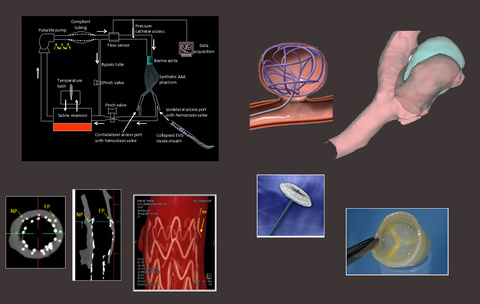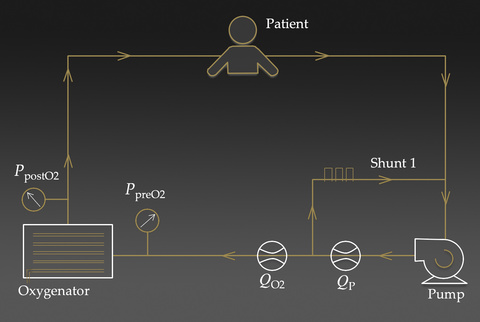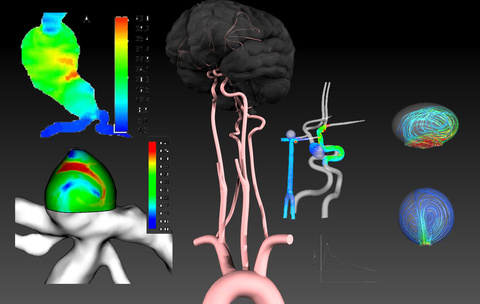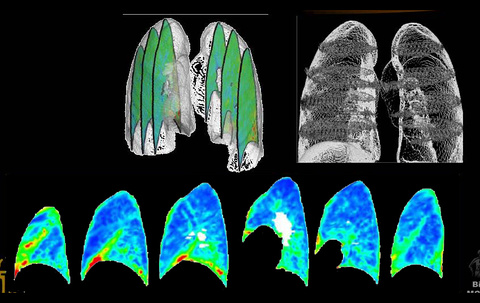Focused research areas
Cardiopulmonary devices
Cardiopulmonary devices

The urge to design, build and tinker defines the quintessential engineer. Even the ones adultered by biology and medicine such as yours truly :-) Luckily there is a whole field to sate that thirst while doing some good - medical devices. Our lab focuses on devices that help repair cardiopulmonary diseases. Pretty much, tools for plumbing the heart, arteries, and airways - tools that help diagnose problems and help correct them. Examples of our work on arterial aneurysms include:
- Design of an electrochemical catheter for measurement of cardiac output - collaboration with Dr. Mubeen Syed, Chemical and Biochemical Engineering, University of Iowa; funded by National Institutes of Health
- Study of the discrepancy between pressure-drop measurements by doppler versus catheter in patients with stented aortic coarctation - collaboration with Department of Pediatrics, University of Iowa
- Development and Evaluation of a Nanometer-Scale Hemocompatible and Antithrombotic Coating Technology Platform for Commercial Intracranial Stents and Flow Diverters - collaboration with Drs. Hasan, Bowden, and Salem, University of Iowa
- Sac growth as etiology of recurrence in coil-embolized brain aneurysms - collaboration with Dr. David Hasan, Neurosurgery, University of Iowa; funded by National Institutes of Health
- Development of a novel biocellulose biomaterial - funded by University of Iowa Research Foundation
- Design and study of transcatheter heart valve prostheses using novel leaflet material - funded by University of Iowa Research Foundation
- Design of aortic stent grafts - how oversizing and design variables affect their deployment and risk of migration - funded by National Institutes of Health
Courses taught by Dr. Raghavan at Iowa that are enhanced by this research: Biomechanics and Biomaterials, Cardiovascular Tissue Mechanics, BME Senior design I and II.
Critical care devices
Critical care devices

Critical care therapies are life-saving interventions in severely ill patients. There is a synergy between our lab’s expertise and interests in experimental and computational blood flow simulations and the critical nature of cardiovascular care at the intensive care unit. Some of our work in critical care therapies are:
- Development of a novel catheter for cardiac output monitoring (with Dr. Syed Mubeen, Chemical and Biochemical Engineering).
- Development of a novel oxygen concentrator for critically ill patients (with Dr. Syed Mubeen, Chemical and Biochemical Engineering)
- Study of flow monitoring during extracorporeal life support. We are testing the hypothesis that blood flow monitoring can serve as a superior alternative to current periodic pressure monitoring of clotting in oxygenators in heart-lung machines - collaboration with Dr. Aditya Badheka, Pediatric Intensive Care, University of Iowa and Joseph Turek, Cardiothoracic Surgery, Duke University
- Study of safe protocols for arterial flushing. We are studying the blood flow mechanics during the flushing of arterial lines in critically ill patients with the goal of improving its safety protocols and potentially developing flushing devices with in-built safety controls
Courses taught by Dr. Raghavan at Iowa that are enhanced by this research: Cardiovascular Tissue Mechanics.
Aneurysms
Aneurysms

Aneurysms are abnormal dilations of arteries in the body. Biomechanical studies provide insights into the phenomenon of rupture, may help identify aneurysms at high rupture risk and develop novel ways to treat them. We study both aortic and brain aneurysms. Examples of our work on arterial aneurysms include:
- Experimental study of the heterogeneity in failure properties of harvested human abdominal aortic aneurysm tissue - collaboration with Vascular Surgery, University of São Paulo School of Medicine; funded by American heart Association, National Science Foundation, FAPESP
- Development of a novel bubble inflation test apparatus for multiracial failure testing of biological soft tissues - unfunded pilot research
- Study of aortic tissue properties and stochastic risk modeling of abdominal aortic aneurysms - collaboration with Dr. Stanislav Polzer, VSB-Technical University of Ostrava, Czech Republic
- Computational human subjects study of geometric, hemodynamic, and tissue mechanical indices as longitudinal predictive factors in the rupture risk of unruptured patient-specific brain aneurysms - collaboration with Dr. Bob Harbaugh, Penn State Neurosurgery, and Dr. David Hasan, UIowa Neurosurgery; funded by National Institutes of Health
- Experimental-computational study of imaging of brain aneurysms - funded by National Institutes of Health
- Computational human subjects study of the predictive utility of wall stress in abdominal aortic aneurysm patients under longitudinal observation - collaboration with Dartmouth Vascular Surgery; funded by National Institutes of Health
Courses taught by Dr. Raghavan at Iowa that are enhanced by this research: Engineering Mechanics: Statics, Mechanics of deformable bodies, Biomechanics and Biomaterials, Cardiovascular Tissue Mechanics, Advanced Biological Soft Tissue Mechanics.
Lung biomechanics
Lung biomechanics

Lung imaging research has long been a major strength of University of Iowa. In collaboration with colleagues in pulmonary imaging, my lab uses principles in engineering mechanics to better characterize aspects of lung function and seeks to use this information to diagnose early onset of lung disease in patients. Examples of our work in pulmonary biomechanics include:
- Role of lung lobar sliding in the mechanics of breathing
- Development of novel measures of lung deformation during breathing - collaboration with Prof. Joseph Reinhardt, University of Iowa; funded by National Institutes of Health
- Development of a method to quantity three-dimensional sliding in the lung lobes at figures and chest wall boundaries - collaboration with Prof. Joseph Reinhardt, University of Iowa; funded by National Institutes of Health
- Study of branch pulmonary artery regurgitation and its association with pulmonary vascular resistance after tetralogy of fallot repair in pediatric subjects - by pediatric cardiology fellowship mentee; funded by National Institutes of Health T32 scholarship (to Pediatrics)
Courses taught by Dr. Raghavan at Iowa that are enhanced by this research: Advanced Biological Soft Tissue Mechanics.
Biomaterials
Biomaterials
We have long been interested in the development of durable, thin biocompatible membranes for cardiovascular applications. Our work in this field began through a collaboration with Professor Emeritus, Vijay Kumar (Pharmaceutics, University of Iowa). Together, we developed a biocellulose membrane that is strong, flexible, and biocompatible. The novel biomaterial membrane was used for fabricating a trascatheter aortic valve. Our work resulted in two patent applications that are pending. The technology we developed was licensed to Medical 21 Inc., a Minneapolis startup that is developing small diameter vascular graft for coronary artery bypass surgery.
US Patents
- B Dickerhoff, RS Farivar, ML Raghavan, V Kumar, “Vascular Prosthetic Assemblies”, US Patent App. 16/787,291
- C Schwarz, V Kumar, M Raghavan, “Methods of producing biosynthetic bacterial cellulose membranes“, US Patent App. 16/061,151